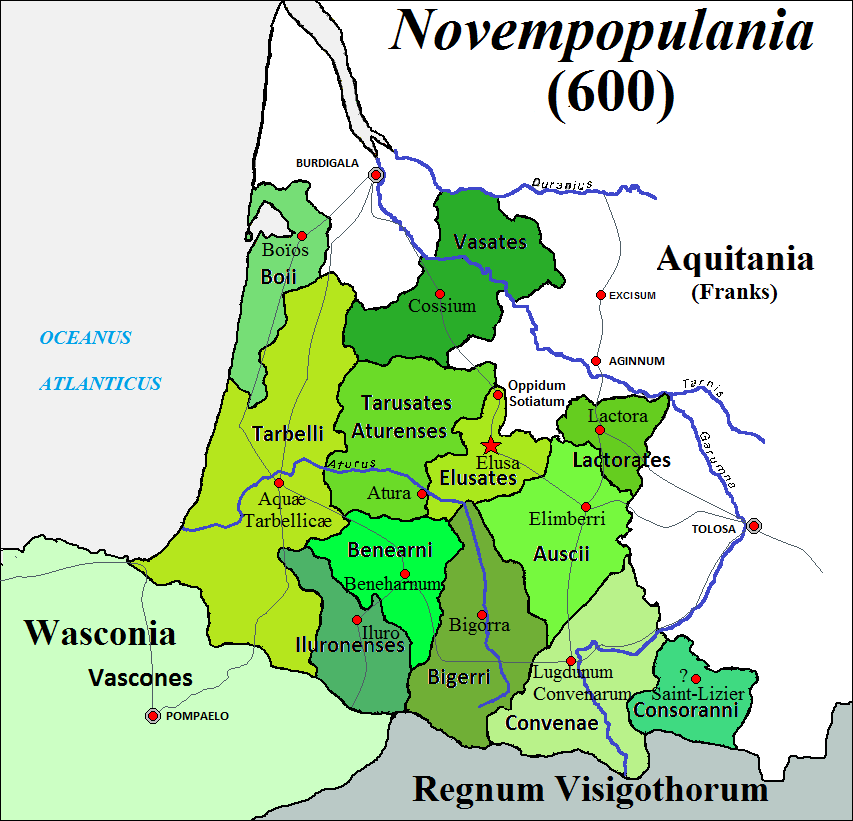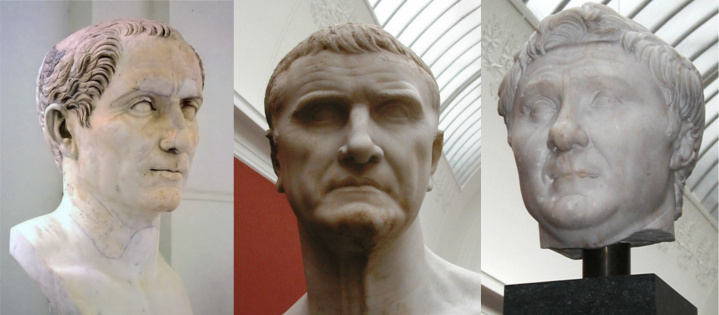|
Sotiates
The Sotiates were a Gallic-Aquitani tribe dwelling in the region surrounding the modern town of Sos (Lot-et-Garonne) during the Iron Age and the Roman period. They were subjugated in 56 BC by the Roman forces of Caesar's legatus P. Licinius Crassus. Name They are mentioned as ''Sotiates'' (var. ''sontiates'', ''sociates'') by Caesar (mid-1st c. BC), and as ''Sottiates'' by Pliny (1st c. AD)., s.v. ''Sotiates'' and ''Sotium''. The meaning of the ethnonym ''Sotiates'' remains unclear. The suffix is possibly the Gaulish -''ates'' ('belonging to'), which appears in the names of many Gallic tribes across Europe (e.g., ''Atrebates'', ''Nantuates'', ''Caeracates''). The origin of the first element ''Soti-'' is still unknown. The city of Sos, attested in the 1st c. BC as ''oppidum Sotiatum'' ('oppidum of the Sotiates'; ''archidiaconatus Socientis'' in the late 13th c. AD) is named after the ancient tribe. Geography The Sotiates dwelled north of the Elusates and Tarusates, sou ... [...More Info...] [...Related Items...] OR: [Wikipedia] [Google] [Baidu] |
Publius Licinius Crassus (son Of Triumvir)
Publius Licinius Crassus (86 or 82 BC – 53 BC) was one of two sons of Marcus Licinius Crassus, the so-called "triumvir", and Tertulla, daughter of Marcus Terentius Varro Lucullus., p.831 He belonged to the last generation of Roman ''nobiles'' who came of age and began a political career before the collapse of the Republic. His peers included Marcus Antonius, Marcus Junius Brutus, Decimus Junius Brutus Albinus, the poet Gaius Valerius Catullus, and the historian Gaius Sallustius Crispus. Publius Crassus served under Julius Caesar in Gaul from 58 to 56 BC. Too young to receive a formal commission from the senate, Publius distinguished himself as a commanding officer in campaigns among the Armorican nations (Brittany) and in Aquitania. He was highly regarded by Caesar and also by Cicero, who praised his speaking ability and good character. Upon his return to Rome, Publius married Cornelia Metella, the intellectually gifted daughter of Metellus Scipio, and began his active politic ... [...More Info...] [...Related Items...] OR: [Wikipedia] [Google] [Baidu] |
Aquitani Tribes Map-fr
The Aquitani were a tribe that lived in the region between the Pyrenees, the Atlantic ocean, and the Garonne, in present-day southwestern France in the 1st century BCE. The Romans dubbed this region ''Gallia Aquitania''. Classical authors such as Julius Caesar and Strabo clearly distinguish the Aquitani from the other peoples of Gaul, and note their similarity to others in the Iberian Peninsula. During the process of Romanization, the Aquitani gradually adopted Latin (Vulgar Latin) and the Roman civilization. Their old language, the Aquitanian language, was a precursor of the Basque language Trask, L. ''The History of Basque'' Routledge: 1997 and the substrate for the Gascon language (one of the Romance languages) spoken in Gascony. History At the time of the Roman conquest, Julius Caesar, who defeated them in his campaign in Gaul, describes them as making up a distinct part of Gaul: Despite apparent cultural and linguistic connections to (Vascones), the area of Aquitania ... [...More Info...] [...Related Items...] OR: [Wikipedia] [Google] [Baidu] |
Aquitani
The Aquitani were a tribe that lived in the region between the Pyrenees, the Atlantic ocean, and the Garonne, in present-day southwestern France in the 1st century BCE. The Romans dubbed this region ''Gallia Aquitania''. Classical authors such as Julius Caesar and Strabo clearly distinguish the Aquitani from the other peoples of Gaul, and note their similarity to others in the Iberian Peninsula. During the process of Romanization, the Aquitani gradually adopted Latin (Vulgar Latin) and the Roman civilization. Their old language, the Aquitanian language, was a precursor of the Basque language Trask, L. ''The History of Basque'' Routledge: 1997 and the substrate for the Gascon language (one of the Romance languages) spoken in Gascony. History At the time of the Roman conquest, Julius Caesar, who defeated them in his campaign in Gaul, describes them as making up a distinct part of Gaul: Despite apparent cultural and linguistic connections to (Vascones), the area of Aquitania ... [...More Info...] [...Related Items...] OR: [Wikipedia] [Google] [Baidu] |
Cocosates
The Cocosates or Cocosates Sexsignani were an Aquitani tribe dwelling in present-day Landes during the Iron Age. Name They are mentioned as ''Cocosates'' by Caesar (mid-1st c. BC), and as ''Cocosates Sexsignani'' by Pliny (1st c. AD). The etymology of the name remains obscure. It can be derived from the Gaulish stem ''cocos''- ('scarlet red') attached to the suffix -''ates'' ('belonging to'). Red is a colour commonly used in personal names (''Cocus'', ''Cocca'', ''Cocidius'', etc.) and associated with warfare., s.v. ''Cocosates (Sexsignani)''. Geography The Cocosates lived in present-day Landes. Their territory was located east of the Atlantic Ocean, west of the Oscidates and Sotiates, north of the Tarbelli and Tarusates, and south of the Boii., Map 25: Hispania Tarraconensis. Their chief town was known as Caequosa (modern Sescouze, near Castets). Political organization The Cocosates were a confederation of six tribes. They were probably clients of the neighbouring ... [...More Info...] [...Related Items...] OR: [Wikipedia] [Google] [Baidu] |
Elusates
The Elusates were an Aquitani tribe dwelling in the modern Gers department, around present-day Eauze, France during the Iron Age and the Roman period. They were subjugated in 56 BC by the Roman forces of Caesar's legatus P. Licinius Crassus. Name They are mentioned as ''Elusates'' by Caesar (mid-1st c. BC) and Pliny (1st c. AD), and as Elusa on the ''Tabula Peutingeriana'' (5th c. AD)., s.v. ''Elusates'' and ''Elusa''. The etymology of the ethnonym ''Elusates'' remains uncertain, but the root ''elus(a)''- is generally presumed to be of Aquitanian origin. Alternatively, a connection with the Celtic root *''elu(o)''- ('numerous') has also been proposed. The city of Eauze, attested in the 4th century AD as ''civitas Elusa'', is named after the tribe. Geography The Elusates dwelled south of the Sotiates, north of the Onobrisates, east of the Tarusates, west of the Lactorates, and northwest of the Ausci., Map 25: Hispania Tarraconensis. The pre-Roman oppidum of Esbé ... [...More Info...] [...Related Items...] OR: [Wikipedia] [Google] [Baidu] |
Oppidum
An ''oppidum'' (plural ''oppida'') is a large fortified Iron Age settlement or town. ''Oppida'' are primarily associated with the Celtic late La Tène culture, emerging during the 2nd and 1st centuries BC, spread across Europe, stretching from Britain and Iberia in the west to the edge of the Hungarian plain in the east. These settlements continued to be used until the Romans conquered Southern and Western Europe. Many subsequently became Roman-era towns and cities, whilst others were abandoned. In regions north of the rivers Danube and Rhine, such as most of Germania, where the populations remained independent from Rome, ''oppida'' continued to be used into the 1st century AD. Definition is a Latin word meaning 'defended (fortified) administrative centre or town', originally used in reference to non-Roman towns as well as provincial towns under Roman control. The word is derived from the earlier Latin , 'enclosed space', possibly from the Proto-Indo-European , 'occupi ... [...More Info...] [...Related Items...] OR: [Wikipedia] [Google] [Baidu] |
Marcus Licinius Crassus
Marcus Licinius Crassus (; 115 – 53 BC) was a Roman general and statesman who played a key role in the transformation of the Roman Republic into the Roman Empire. He is often called "the richest man in Rome." Wallechinsky, David & Wallace, Irving.Richest People in History Ancient Roman Crassus. Trivia-Library. ''The People's Almanac''. 1975–1981. Web. 23 December 2009."Often named as the richest man ever, a more accurate conversion of sesterce would put his modern figure between $200 million and $20 billion." Peter L. BernsteinThe 20 Richest People Of All Time/ref> Crassus began his public career as a military commander under Lucius Cornelius Sulla during his civil war. Following Sulla's assumption of the dictatorship, Crassus amassed an enormous fortune through real estate speculation. Crassus rose to political prominence following his victory over the slave revolt led by Spartacus, sharing the consulship with his rival Pompey the Great. A political and financi ... [...More Info...] [...Related Items...] OR: [Wikipedia] [Google] [Baidu] |
Gallia Aquitania
Gallia Aquitania ( , ), also known as Aquitaine or Aquitaine Gaul, was a province of the Roman Empire. It lies in present-day southwest France, where it gives its name to the modern region of Aquitaine. It was bordered by the provinces of Gallia Lugdunensis, Gallia Narbonensis, and Hispania Tarraconensis.John Frederick Drinkwater (1998). "Gaul (Transalpine)". ''The Oxford Companion to Classical Civilization.'' Ed. Simon Hornblower and Antony Spawforth. Oxford University PressOxford Reference Online Tribes of Aquitania Fourteen Celtic tribes and over twenty Aquitanian tribes occupied the area from the northern slopes of the Pyrenees in the south to the ''Liger'' (Loire) river in the north. The major tribes are listed at the end of this section.''Strabo: The Geography''The Aquitani There were more than twenty tribes of Aquitani, but they were small and lacking in repute; the majority of the tribes lived along the ocean, while the others reached up into the interior and to the sum ... [...More Info...] [...Related Items...] OR: [Wikipedia] [Google] [Baidu] |
Cassius Dio
Lucius Cassius Dio (), also known as Dio Cassius ( ), was a Roman historian and senator of maternal Greek origin. He published 80 volumes of the history on ancient Rome, beginning with the arrival of Aeneas in Italy. The volumes documented the subsequent founding of Rome (753 BC), the formation of the Republic (509 BC), and the creation of the Empire (27 BC), up until 229 AD. Written in Ancient Greek over 22 years, Dio's work covers approximately 1,000 years of history. Many of his 80 books have survived intact, or as fragments, providing modern scholars with a detailed perspective on Roman history. Biography Lucius Cassius Dio was the son of Cassius Apronianus, a Roman senator and member of the gens Cassia, who was born and raised at Nicaea in Bithynia. Byzantine tradition maintains that Dio's mother was the daughter or sister of the Greek orator and philosopher, Dio Chrysostom; however, this relationship has been disputed. Although Dio was a Roman citizen, he wrote in Gree ... [...More Info...] [...Related Items...] OR: [Wikipedia] [Google] [Baidu] |
Commentarii De Bello Gallico
''Commentarii de Bello Gallico'' (; en, Commentaries on the Gallic War, italic=yes), also ''Bellum Gallicum'' ( en, Gallic War, italic=yes), is Julius Caesar's firsthand account of the Gallic Wars, written as a third-person narrative. In it Caesar describes the battles and intrigues that took place in the nine years he spent fighting the Celtic and Germanic peoples in Gaul that opposed Roman conquest. The "Gaul" that Caesar refers to is ambiguous, as the term had various connotations in Roman writing and discourse during Caesar's time. Generally, Gaul included all of the regions primarily inhabited by Celts, aside from the province of Gallia Narbonensis (modern-day Provence and Languedoc-Roussillon), which had already been conquered in Caesar's time, therefore encompassing the rest of modern France, Belgium, Western Germany, and parts of Switzerland. As the Roman Republic made inroads deeper into Celtic territory and conquered more land, the definition of "Gaul" shifted. Concu ... [...More Info...] [...Related Items...] OR: [Wikipedia] [Google] [Baidu] |
Gélise
The Gélise () is a tributary of the river Baïse in Gascony, southwestern France. It is long. Etymology The name Gélise comes from the Aquitanian hydronymic root ''Jel'', meaning "watercourse." Geography The Gélise originates in the Gers ''département'' at Cahuzères, north of Lupiac, then it flows northwest in the direction of Eauze. It drains the land around Castelnau-d'Auzan, then it flows northeast where it forms the natural boundary between the forest of the Landes of Gascony, the slopes of the Armagnac-Ténarèze. It unites with the Baïse just after passing the fortified mill of Lavardac in Lot-et-Garonne. The Osse, a right tributary, joins the Gélise near Nérac. The Auzoue, a right tributary, joins the Gélise at Mézin. The Izaute, a right tributary, joins the Gélise at Saint-Pé-Saint-Simon. Départements and principal cities The Gélise passes through the following ''départements'' and cities: * Gers: Dému, Eauze * Lot-et-Garonne: Sos, Poude ... [...More Info...] [...Related Items...] OR: [Wikipedia] [Google] [Baidu] |
_(cropped).jpg)




